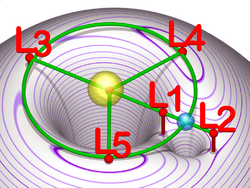Physics:Effective potential
The effective potential (also known as effective potential energy) combines multiple, perhaps opposing, effects into a single potential. In its basic form, it is the sum of the 'opposing' centrifugal potential energy with the potential energy of a dynamical system. It may be used to determine the orbits of planets (both Newtonian and relativistic) and to perform semi-classical atomic calculations, and often allows problems to be reduced to fewer dimensions.
Definition
The basic form of potential [math]\displaystyle{ U_\text{eff} }[/math] is defined as: [math]\displaystyle{ U_\text{eff}(\mathbf{r}) = \frac{L^2}{2 \mu r^2} + U(\mathbf{r}), }[/math] where
- L is the angular momentum
- r is the distance between the two masses
- μ is the reduced mass of the two bodies (approximately equal to the mass of the orbiting body if one mass is much larger than the other); and
- U(r) is the general form of the potential.
The effective force, then, is the negative gradient of the effective potential: [math]\displaystyle{ \begin{align} \mathbf{F}_\text{eff} &= -\nabla U_\text{eff}(\mathbf{r}) \\ &= \frac{L^2}{ \mu r^3} \hat{\mathbf{r}} - \nabla U(\mathbf{r}) \end{align} }[/math] where [math]\displaystyle{ \hat{\mathbf{r}} }[/math] denotes a unit vector in the radial direction.
Important properties
There are many useful features of the effective potential, such as [math]\displaystyle{ U_\text{eff} \leq E . }[/math]
To find the radius of a circular orbit, simply minimize the effective potential with respect to [math]\displaystyle{ r }[/math], or equivalently set the net force to zero and then solve for [math]\displaystyle{ r_0 }[/math]: [math]\displaystyle{ \frac{d U_\text{eff}}{dr} = 0 }[/math] After solving for [math]\displaystyle{ r_0 }[/math], plug this back into [math]\displaystyle{ U_\text{eff} }[/math] to find the maximum value of the effective potential [math]\displaystyle{ U_\text{eff}^\text{max} }[/math].
A circular orbit may be either stable or unstable. If it is unstable, a small perturbation could destabilize the orbit, but a stable orbit would return to equilibrium. To determine the stability of a circular orbit, determine the concavity of the effective potential. If the concavity is positive, the orbit is stable: [math]\displaystyle{ \frac{d^2 U_\text{eff}}{dr^2} \gt 0 }[/math]
The frequency of small oscillations, using basic Hamiltonian analysis, is [math]\displaystyle{ \omega = \sqrt{\frac{U_\text{eff}''}{m}} , }[/math] where the double prime indicates the second derivative of the effective potential with respect to [math]\displaystyle{ r }[/math] and it is evaluated at a minimum.
Gravitational potential

Consider a particle of mass m orbiting a much heavier object of mass M. Assume Newtonian mechanics, which is both classical and non-relativistic. The conservation of energy and angular momentum give two constants E and L, which have values [math]\displaystyle{ E = \frac{1}{2}m \left(\dot{r}^2 + r^2\dot{\phi}^2\right) - \frac{GmM}{r}, }[/math] [math]\displaystyle{ L = mr^2\dot{\phi} }[/math] when the motion of the larger mass is negligible. In these expressions,
- [math]\displaystyle{ \dot{r} }[/math] is the derivative of r with respect to time,
- [math]\displaystyle{ \dot{\phi} }[/math] is the angular velocity of mass m,
- G is the gravitational constant,
- E is the total energy, and
- L is the angular momentum.
Only two variables are needed, since the motion occurs in a plane. Substituting the second expression into the first and rearranging gives [math]\displaystyle{ m\dot{r}^2 = 2E - \frac{L^2}{mr^2} + \frac{2GmM}{r} = 2E - \frac{1}{r^2} \left(\frac{L^2}{m} - 2GmMr\right), }[/math] [math]\displaystyle{ \frac{1}{2} m \dot{r}^2 = E - U_\text{eff}(r), }[/math] where [math]\displaystyle{ U_\text{eff}(r) = \frac{L^2}{2mr^2} - \frac{GmM}{r} }[/math] is the effective potential.[Note 1] The original two-variable problem has been reduced to a one-variable problem. For many applications the effective potential can be treated exactly like the potential energy of a one-dimensional system: for instance, an energy diagram using the effective potential determines turning points and locations of stable and unstable equilibria. A similar method may be used in other applications, for instance determining orbits in a general relativistic Schwarzschild metric.
Effective potentials are widely used in various condensed matter subfields, e.g. the Gauss-core potential (Likos 2002, Baeurle 2004) and the screened Coulomb potential (Likos 2001).
See also
Notes
- ↑ A similar derivation may be found in José & Saletan, Classical Dynamics: A Contemporary Approach, pgs. 31–33
References
- ↑ Seidov, Zakir F. (2004). "Seidov, Roche Problem". The Astrophysical Journal 603: 283–284. doi:10.1086/381315. Bibcode: 2004ApJ...603..283S.
Further reading
- José, JV; Saletan, EJ (1998). Classical Dynamics: A Contemporary Approach (1st ed.). Cambridge University Press. ISBN 978-0-521-63636-0..
- Likos, C.N. et al. (2002). "Gaussian effective interaction between flexible dendrimers of fourth generation: a theoretical and experimental study". J. Chem. Phys. 117 (4): 1869–1877. doi:10.1063/1.1486209. Bibcode: 2002JChPh.117.1869L. Archived from the original on 2011-07-19. https://web.archive.org/web/20110719010918/http://jcp.aip.org/jcpsa6/v117/i4/p1869_s1?isAuthorized=no.
- Baeurle, S.A.; Kroener J. (2004). "Modeling Effective Interactions of Micellar Aggregates of Ionic Surfactants with the Gauss-Core Potential". J. Math. Chem. 36 (4): 409–421. doi:10.1023/B:JOMC.0000044526.22457.bb.
- Likos, C.N. (2001). "Effective interactions in soft condensed matter physics". Physics Reports 348 (4–5): 267–439. doi:10.1016/S0370-1573(00)00141-1. Bibcode: 2001PhR...348..267L.
 |



